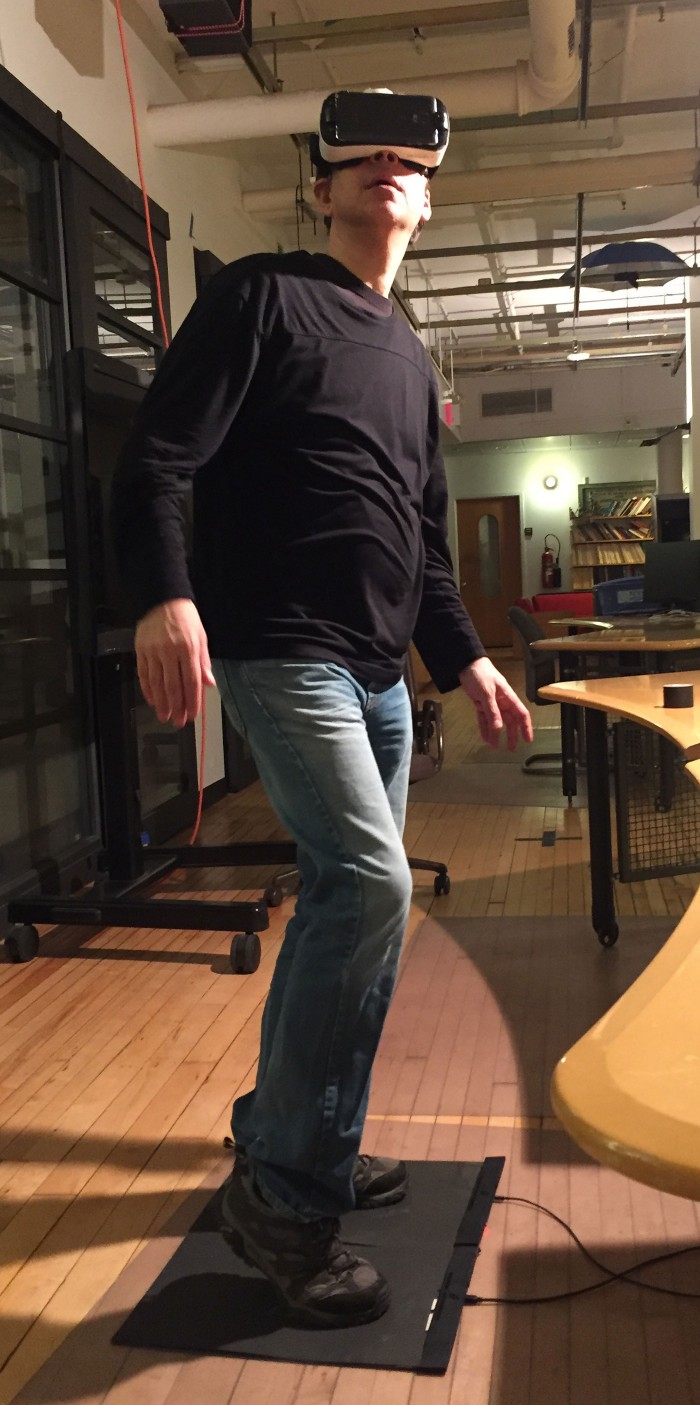Bring Your Feet into Virtual Reality
While companies like Oculus and HTC are focused on what you’ll do with your head and your hands in virtual reality, a small startup is paying attention to how you’ll use your feet.
Tactonic Technologies, based in New York, is making pressure-sensing floor mats that can measure, among other things, just how you wiggle your toes or shift your weight, detecting up to four touches per square inch on its surface. Initially, the company hopes the mats will be used with virtual-reality headsets like Samsung’s Gear VR or Oculus’s forthcoming Rift to play games and engage with other applications, giving you a more natural sense of motion and, perhaps, better enabling you to control a full-body avatar.
Ken Perlin, the company’s chief scientific advisor and also a computer science professor at New York University’s Media Research Lab, believes the Tactonic mat can make moving around in VR more intuitive than using handheld controls, and less likely to make users feel sick.

“You’re thinking, ‘I want to move this way, I want to move that way,’ and you start moving this way or that way,” he says.
If it sounds similar to what another pressure-sensing startup called Sensel is doing—that company is making a tablet-computer-sized pad for picking up a range of touches made by fingers and other tools—there’s a good reason. Several of the people behind both companies previously worked together on a pressure-sensing touch-screen company, Touchco, which was purchased in 2010 by Amazon.
Yet while Sensel is focused on a small, super-sensitive pad for your hands, Tactonic has spent the past five years building something larger for feet.
Perlin says the company plans to start offering a 24- by 18-inch mat and software tools that go along with it to developers between April and June, in hopes that they’ll come up with ways to use the mats with, say, virtual reality games (Tactonic’s software will work with standard game engines, such as Unity). He would like to start selling a mat to consumers for around $200 late this year, though he acknowledges the timing may not work out.
In a video demonstration, people use a prototype Tactonic mat and either a Gear VR headset or an HTC Vive to simulate flying through the air in an animated world, bending and flexing their sneaker-clad feet to move over and past simple geometric blocks and pyramids.
To make this work, the mat includes hundreds of little force plates set a half-inch apart. Pressure-imaging data gathered from the movement of a user’s feet—they can be bare or shoe-clad—is sent to a computer that’s connected to the mat via USB, where software analyzes it in real time and translates it into actions that a game engine can use in VR, to do things like making it look like you’re tilting left or right or gaining or losing altitude.
The mats can be used individually or tiled together; Perlin says the version that will be offered to developers will connect directly to a computer, but a consumer product would be able to work wirelessly via Bluetooth.
Perlin imagines non-virtual-reality applications for Tactonic as well. A room at NYU is set to be tiled with 24 square feet of the mats, along with motion-capture cameras, to compare the force data captured from people’s feet moving on the mats to their body positions as captured by the cameras—potentially useful for fields like dance, animation, physical therapy, and sports.
Still, for now, he says, “VR is by far the best market we’ve discovered for what this thing does.”
Keep Reading
Most Popular
Large language models can do jaw-dropping things. But nobody knows exactly why.
And that's a problem. Figuring it out is one of the biggest scientific puzzles of our time and a crucial step towards controlling more powerful future models.
How scientists traced a mysterious covid case back to six toilets
When wastewater surveillance turns into a hunt for a single infected individual, the ethics get tricky.
The problem with plug-in hybrids? Their drivers.
Plug-in hybrids are often sold as a transition to EVs, but new data from Europe shows we’re still underestimating the emissions they produce.
Stay connected
Get the latest updates from
MIT Technology Review
Discover special offers, top stories, upcoming events, and more.